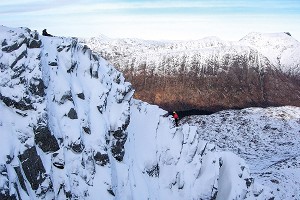
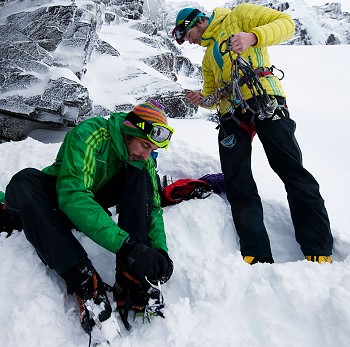
It's not just locals who have made their mark in Scotland (Swiss climber Dani Arnold made an ascent of The Hurting (XI,11) in Coire an t-Sneachda last season), foreign climbers have visited for many years. Those from overseas who have left their mark include Yvon Chouinard, Doug Tomkins, Marko Prezelj, Ueli Steck, Steve House, Ines Papert, Kelly Cordes, Bruno Sourzac, Sean Isaac, Florian Schranz, Heinz Zak, Egon Netzer and of course Godefroy Perroux who authored a guidebook to winter climbing on Ben Nevis.
Below we have an account of part of Charly and Matthias's trip written by Mike Mandl and Flo Scheimpflug of Austria's Climax magazine which gives a novices viewpoint of Scottish winter climbing! Although the level Charly and Matthias climb at is hardly the novice level. AND... a great video featuring Charly, Matthias, Will Sim and Greg Boswell. But first we asked the young UK alpinist Will Sim about Charly and Matthias.

Will told us:
I first met both Charly and Matthias in Patagonia in 2010; my last memories of seeing them was bouncing around a night club in Argentina at about 5 in the morning. So it was pretty random when our next meeting was in a dark and rainy Cairngorm car-park at a similar time of the morning a year later! - sometimes I reckon things like that are what make climbing really special!!
...there was a line in Lochain, one of the few still to go, that Greg (Boswell) and myself were thinking about trying, but one morning Charly and Matthias had walked in ahead of us, and a little to our surprise when we reached the corrie, Charly was perched at the top of the pitch after making the FA with a wide grin on his face. I think he gave it VII, but it's now settled at about IX. They called it "Pfugga-lule" which means "friendship" or something like that; as they'd felt very welcome in Scotland.
One really interesting thing about going out in Scotland with such capable foreign climbers is that it makes you realise just how incredibly special our ethics are. For example with regards to conditions, myself and Greg would often find ourselves attempting to explain where the "line" is regarding what is "in" condition and what isn't, but the more we tried to explain the more unsure we became ourselves about what constitutes an in condition mixed route in Scotland. It really made me realise; if I don't really understand whats "in" and what "isn't", how were we supposed to expect them to understand!
Simon Richardson at www.scottishwinter.com reported on Charly and Matthias's route Pfugelule: The Austrians first climbed the route on almost dry snowless rock in mid January, but when they heard feedback that these conditions were not acceptable, they returned and reclimbed the route in bona fide winter conditions after it had snowed a few days later.
Will continues:
When you watch someone like Charly climb thin, insecure mixed with no gear, in a discipline of climbing he has done very little of (he doesn't winter climb much), it makes you realise there's absolutely no substitute for having a really high standard of rock climbing - the man onsights 8b!
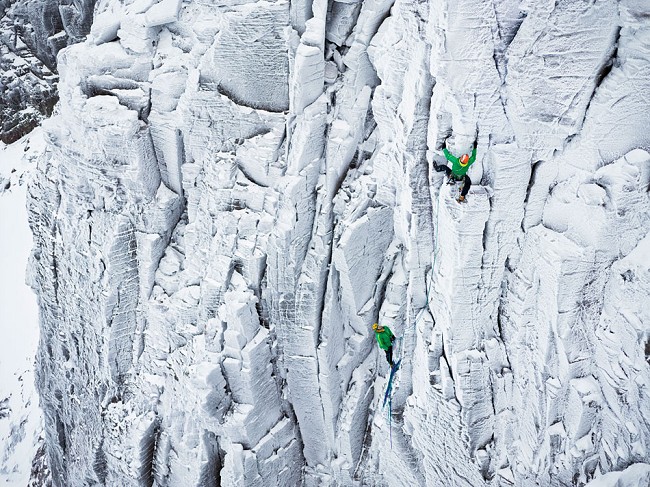
ARTICLE AND VIDEO: Scotland: Rough Feels Good
Charly carefully inserts his ice axe into a thin layer of hard snow, or rime, on the surface of the rock. Whether it is going to hold or not still has to be decided by the Scottish mountain goblins. What is certain is that the next trustworthy hold seems further away than the nearest whisky distillery. "Keep cool" thinks Charly. "Pfugelule," as he would say in dialect back in Carinthia/Austria. And that is the name that will be given to the route that Charly is fighting his way up at the moment.
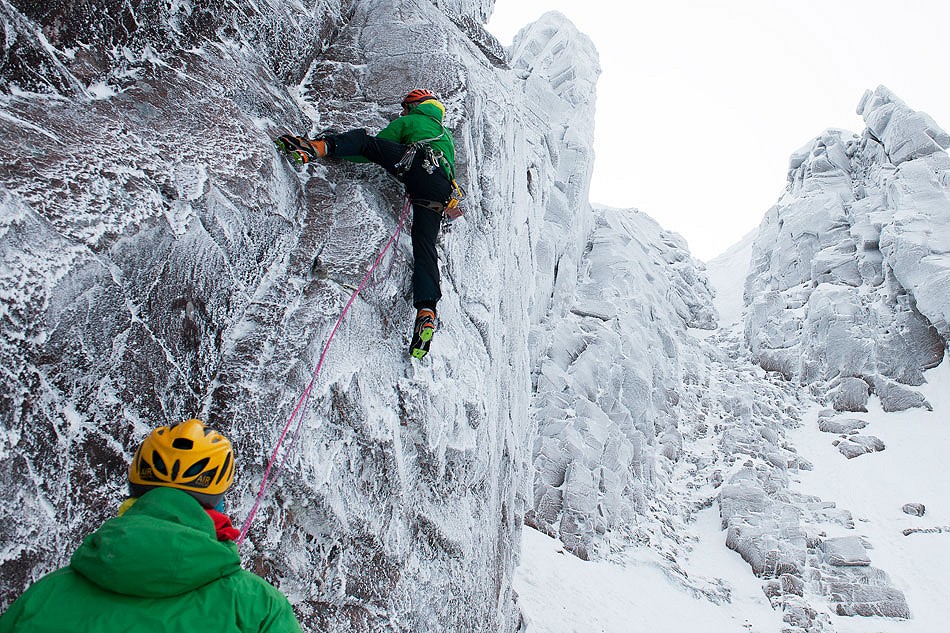
If you ever hear this name again, then that can only mean one thing: you have let yourself in for the adventure that is Scottish mixed climbing.
To understand the uniqueness of the Scottish attitude towards climbing, it is perhaps necessary to remind visitors of what is uniquely Scottish.
For novices, here are the top three.
1. The bagpipes: an instrument as stirring as the sound that it spits out.
2. The kilt: no other item of clothing manages to frame men's legs so stunningly.
3. The whisky: in Scotland they have known what to do with grain, apart from bake bread, since the 5th century.
Self-appointed Scotland experts will go on to add tossing the caber.
This is the Scottish national sport that quite simply involves throwing a tree trunk around – a kind of oversized pick-up sticks for the excessively strong. After a day of tossing cabers, for your typical Scot there is nothing better than haggis, and then being struck by lightening to make him immortal.
In short, the national customs here are based on a long tradition, are creative and not lacking in extravagance. And the same goes for mixed climbing.
In Scotland, climbing routes with alternating sections of rock and ice have a long tradition. Of course ice climbing equipment is used in numerous countries around the globe. But the term "Scottish mixed"has developed as a result of the extreme and inimitable conditions in Scotland. A daring, no-compromise style, regarded with awe whenever climbers of the frozen verticals gather together.
"One really interesting thing about going out in Scotland with such capable foreign climbers is that it makes you realise just how incredibly special our ethics are." Will Sim.
Listening to tales of awesome achievement can be entertaining, but it doesn't get really exciting until you get to grips with it yourself. And that was what Charly Fritzer and Matthias Wurzer intended to do as they set off from Austria to Scotland.
Winter climbing in Scotland is a serious business that has given many a novice its ice-cold shoulder, who can be grateful if they came away only lightly scathed.
Matthias: "I watched a lot of Scottish climbing videos on YouTube. I felt really drawn to it, but at the same time felt fear at the prospect."
After all, it's not often that foreign climbing teams venture into the Highlands to spend a holiday at the limit of their nerves, as the locals will tell you. There are more relaxing ways to spend your time.
However: "In Austria we are all familiar with innumerable waterfalls, our freezing testing grounds, and the weather conditions. That is why you simply have to experience something different. And that is where Scotland comes in," says Matthias.
Preparation was not half the battle in this case, but at least gave them the edge. Before they set off Charly and Matthias put in some serious training sessions. But how can you prepare for such adverse conditions? Standing under a cold shower followed by chin-up sessions naked in a wind tunnel perhaps? No thanks sunshine. "Plenty of training with ice axes, dry tools, mixed climbs and running up north faces – and whatever else you can manage," seemed to make more sense, says Charly. The strategy worked: "The preparations really did me a lot of good. Especially managing to keep up with Charly. That guy is truly ripped," says Matthias.
Another important element you need to bring with you before committing to such extreme climbs without being able to train in advance: friendship and trust in your climbing partner. Should be no problem for these guys since they've been climbing together for almost five years. Charly, 31, born in Carinthia/Austria but now living in Berchtesgaden/Germany, and Matthias, 29,a professional mountain guide from Kals in Tyrol/Austria, have become a team for whom no corner of the world is too wild.
VIDEO: Scotland: Rough Feels Good
Missing video!
One of their more recent travels took them to Patagonia – in a tiebreak with Scotland for the worst weather worldwide – where they tested their resistance to the elements while climbing Cerro Torre, Exupery and Fitz Roy. Summing up their teamwork so far, "I've experienced some really wild things with Charly and we work really well together as a team. Of course we are both committed to completing our projects successfully. However, fun and friendship are still the most important things," says Matthias.
The Scottish Highlands aren't particularly high:
The highest mountain is Ben Nevis at 4,409 ft – which works out at just 1,344 metres – lowly by Alpine standards. But it's the sheer expanse of the Highlands that makes the difference. As a rookie there's an excellent chance you'll get lost out in the sticks, covering more ground than strictly necessary to pinpoint perfect climbs. Charly and Matthias don't intend to do that. One string to their bow is that Charly visited Scotland last year to climb some more difficult routes with the Ice Queen, Ines Papert, including the extreme challenge of Bavarinthia (IX/9).
Plus, they made friends with two of the toughest aficionados of Scottish mixed climbing: the young and talented Will Sim and the dyed-in-the-wool Scottish mixed climber Greg Boswell who both know the most important climbing areas and the local conditions like the back of their hand. Greg lives most of the time in Scotland; Will in not un-icy Chamonix.
So two indulging in a shared passion soon became four.
Having spent some time together climbing all over the shop, Charly and Matthias soon started to understand the "principles" of Scottish mixed climbing:
The Principles of Scottish Mixed Climbing According To Charly and Matthias
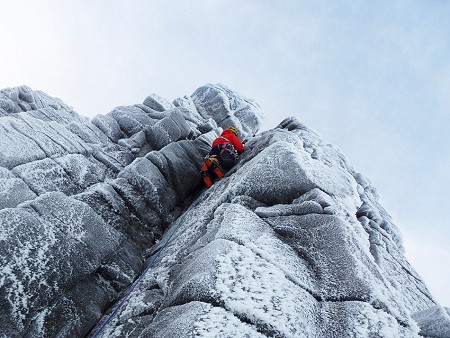
1.
The weather is never bad, because it's usually terrible. Low pressure systems blowing in from the Atlantic hit Scotland first to demonstrate which meteorological pleasantries are on the menu. It's never really cold, but at near freezing temperatures you better be prepared for a merciless wind and pea-souper visibility. But that hardly affects climbing because, as Will says: "We climb in that bad weather because it's the only weather."
2.
Because the temperatures only just dip into minus figures, there is no ice but rime instead. Rime is a substance halfway between snow and ice, possessing properties of both without deciding firmly what it is going to be. Rime is neither one nor the other. Rime, which is formed from damp air, is pressed onto the rock by the wind at high pressure to create imaginative shapes that look more promising than they actually turn out to be. Climbers expecting a safe hold are destined to spend a great deal of time cussing and swearing. If you haven't climbed rime, then by Scottish standards you haven't done a winter climb. Which means you won't have earned haggis for your tea.
3.
Strength isn't everything, in fact in these conditions it's only a small part of the story. What you really need are strong nerves. Without them you needn't even start thinking about attempting Scottish mixed climbing. There are other ways of passing your time here. Tossing the caber, for example.
4.
Whoever dares defy the Scottish ethic and drill a bolt, will be banned from climbing for life.5.
You need to be on first name terms with your rocks, friends and hexes.
6.
The above principles are what the fascination of Scottish mixed climbing is all about. 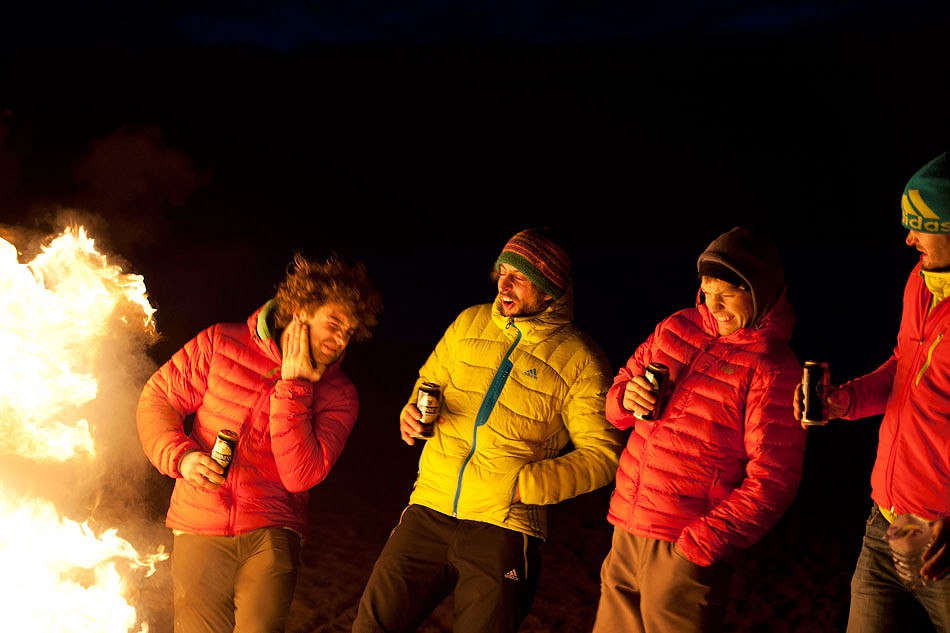
and then there's the grading system.........
Grading is also calculated slightly differently in Scotland than on the Continent or in Canada and the USA. While they denote routes featuring rock and ice with WI (for waterfall ice) and M (for mixed), in Scotland the grading system goes into more detail. The Scottish mixed scale consists of a roman numeral to indicate the overall grade, followed by a second figure referring to the most difficult section of the climb. The scale goes up to grade XI, although this is a subject of controversy because it depends very much on the actual conditions. The overall grade is intended to give an idea of the physical demands of the climb as a result of the sparse protection that can be used. That's why difficult routes are also extremely demanding physically.
Matthias: "It's all about protection, or the lack of it. You start crapping yourself if you think too much about the last protection you set being way below you, and that it is probably not all that good. Friends simply don't hold that well in iced-up cracks covered in rime. But when it's behind you and you've pointed the climb, then you've all the more reason to be proud of yourself. Your pint of Eighty Shilling tastes brilliant after that!"
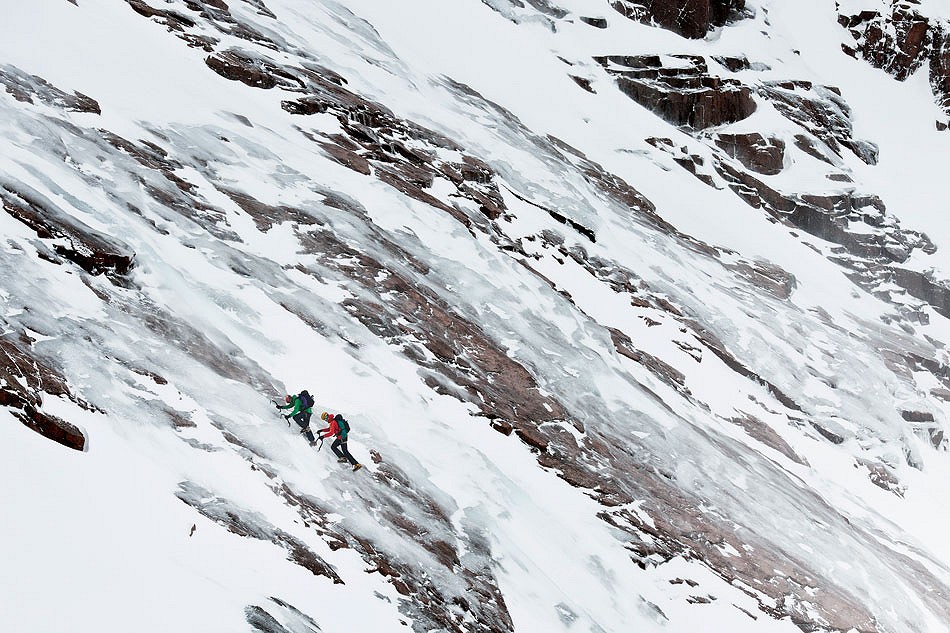
So climbing in Scotland requires a strong heart, strict rules and respect for the ethics. Off-putting for some, inviting for others, as proven by the impressive list of climbs notched up by Matthias and Charly.
During their seven-day tour they bagged a number of climbs in Cairngorms National Park on Coire an Lochain, among others, including Fall Out Corner (VI/7), Nocando Crack (VII/8) and Pic 'n Mix (IX/9), which for Matthias was "the best route there is where everything went to plan." To top that, Charly conquered The Secret (X/10) on Ben Nevis. In his opinion he would have rated it grade VIII/9, which goes to show that a) even an outsider can develop a feel for Scottish climbing, and b) even non-Scots can excel at mixed.
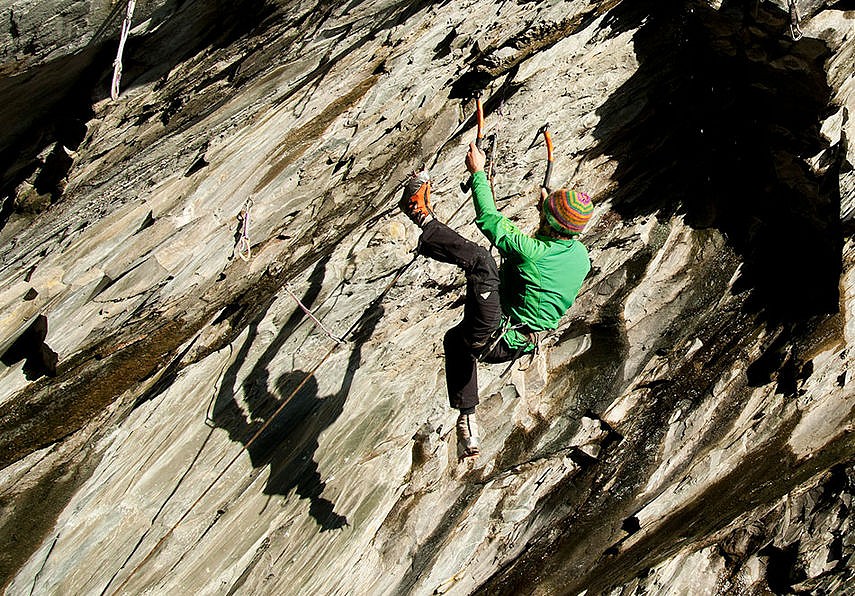
In Scotland there is more to setting protection in rime; you also need to know your way around with classic drytool work. But only "if the conditions aren't suitable for the mixed routes and you need to keep in shape," says Charly. What is meant by "unsuitable conditions" nobody really knows. What they probably mean is blue sky and blazing sunshine, because setting off with your ice axe on a high is deeply un-Scottish. Fine weather or not, the way Charly handles dry tools is pretty much perfect and as a result he was able to climb Too Fast and Too Furious (M 11+), one of the toughest there is, at first attempt and flash Torchlite (M 11).
Souvenirs
Charly and Matthias have brought back a number of souvenirs in the form of cool routes that they will remember for a long time. But what about the friendly Scots?
As you would expect from visiting climbers, Matthias and Charly left behind something that their hosts can look forward to whenever the rime hugs the rock face: Pfugelule (VIII/9) is its name. If you want to climb Pfugelule, you should at least attempt to understand what the name means. In Charly's dialect back home in Carinthia/Austria, Pfugelule means something like: "Take it easy and keep your cool."
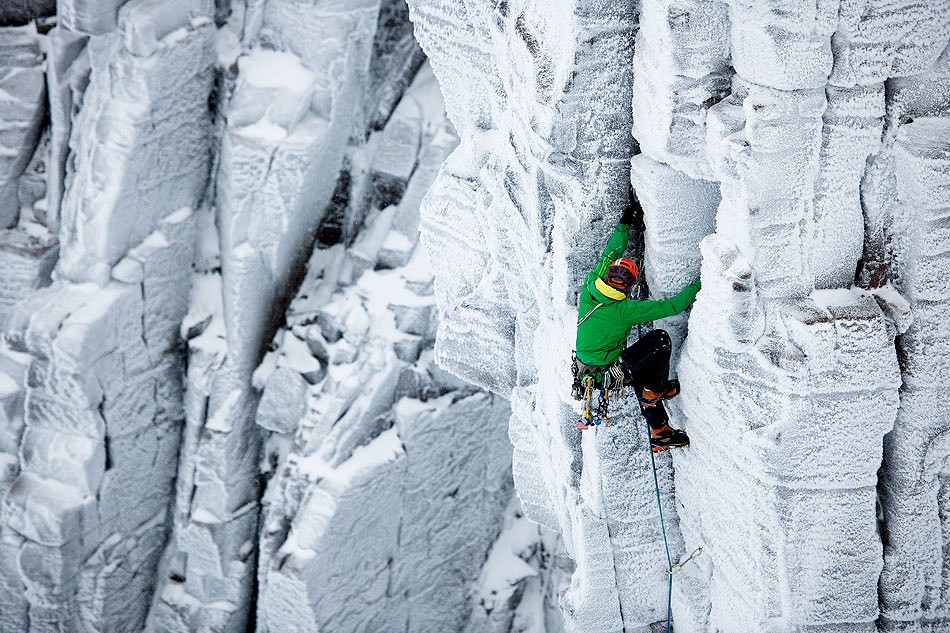
Looking back, the question that they were asking themselves was whether winter mixed climbing really is as difficult as everybody says, and do you need to take out life insurance and sign a will before you get started? Do you really have to be as immortal as a Highlander to climb and descend these routes unscathed?
As Charly says: "A route is not just awesome because it is difficult, but the grade of difficulty certainly has its attraction. On reflection, all the routes we climbed were beautiful, regardless of how difficult they were."
Matthias says: "You don't need to believe all the rumours; the Scots don't wear kilts while they are climbing either. There are routes of all grades. It's just that many climbs are well off the beaten track. You've got to make sure nothing goes wrong, even on an easy climb!" And if you dare tackle some of the more serious routes in Scotland, it's not just strong nerves you need, but also a realistic assessment of your own capabilities. Charly adds: "You certainly need experience climbing with the right kind of protection as well as extensive winter alpine climbing skills."
As with any challenging route, the question you've got to ask yourself is what kind of potential risk are you prepared to take on board to successfully complete the climb. As Charly says: "A route is not just awesome because it is difficult, but the grade of difficulty certainly has its attraction. On reflection, all the routes we climbed were beautiful, regardless of how difficult they were." Matthias adds: "The surroundings, the landscape and the whole way of life are really impressive up there."

You can read more adidas outdoor articles at www.adidas.co.uk/outdoor where you can also download an iPad app with more adidas outdoor features.
Find out more about what happened on Scottish ice last season at Simon Richardson's www.scottishwinter.com and the UKC News Page.

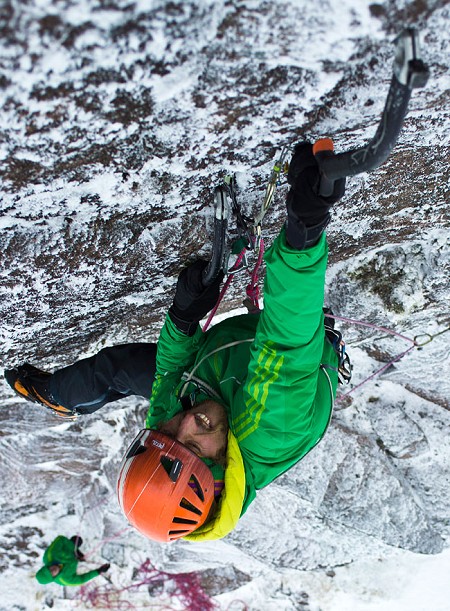
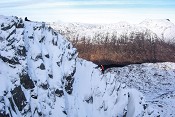
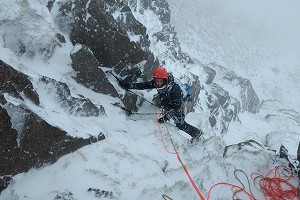

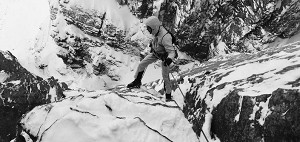









Comments